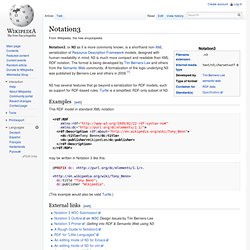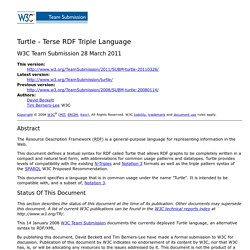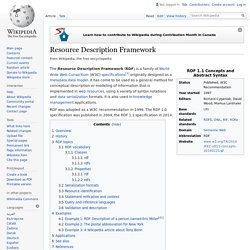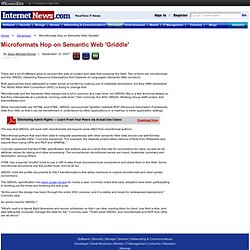

Notation3. Notation3, or N3 as it is more commonly known, is a shorthand non-XML serialization of Resource Description Framework models, designed with human-readability in mind: N3 is much more compact and readable than XML RDF notation.

The format is being developed by Tim Berners-Lee and others from the Semantic Web community. A formalization of the logic underlying N3 was published by Berners-Lee and others in 2008.[1] Examples[edit] This RDF model in standard XML notation. Turtle (syntax) Turtle (Terse RDF Triple Language) is a format for expressing data in the Resource Description Framework (RDF) data model with the syntax similar to SPARQL. RDF, in turn, represents information using "triples", each of which consists of a subject, a predicate, and an object. Each of those items is expressed as a Web URI. Turtle provides a way to group three URIs to make a triple, and provides ways to abbreviate such information, for example by factoring out common portions of URIs.
For example: < . SPARQL, the query language for RDF, uses a syntax similar to Turtle for expressing query patterns. Turtle - Terse RDF Triple Language. Abstract The Resource Description Framework (RDF) is a general-purpose language for representing information in the Web.

This document defines a textual syntax for RDF called Turtle that allows RDF graphs to be completely written in a compact and natural text form, with abbreviations for common usage patterns and datatypes. Turtle provides levels of compatibility with the existing N-Triples and Notation 3 formats as well as the triple pattern syntax of the SPARQL W3C Proposed Recommendation. This document specifies a language that is in common usage under the name "Turtle".
It is intended to be compatible with, and a subset of, Notation 3. Resource Description Framework - Wikipedia, the free encyclopedi. The Resource Description Framework (RDF) is a family of World Wide Web Consortium (W3C) specifications[1] originally designed as a metadata data model.

It has come to be used as a general method for conceptual description or modeling of information that is implemented in web resources, using a variety of syntax notations and data serialization formats. It is also used in knowledge management applications. RDF was adopted as a W3C recommendation in 1999. The RDF 1.0 specification was published in 2004, the RDF 1.1 specification in 2014. Overview[edit] RDF is an abstract model with several serialization formats (i.e. file formats), so the particular encoding for resources or triples varies from format to format. As RDFS and OWL demonstrate, one can build additional ontology languages upon RDF.
History[edit] Resource Description Framework. Semantic Web Stack. Semantic Web Stack The Semantic Web Stack, also known as Semantic Web Cake or Semantic Web Layer Cake, illustrates the architecture of the Semantic Web.

Overview[edit] The Semantic Web Stack is an illustration of the hierarchy of languages, where each layer exploits and uses capabilities of the layers below. It shows how technologies that are standardized for Semantic Web are organized to make the Semantic Web possible. Théorie des graphes. Un article de Wikipédia, l'encyclopédie libre.

La théorie des graphes est une théorie informatique et mathématique. Les algorithmes élaborés pour résoudre des problèmes concernant les objets de cette théorie ont de nombreuses applications dans tous les domaines liés à la notion de réseau (réseau social, réseau informatique, télécommunications, etc.) et dans bien d'autres domaines (par exemple génétique) tant le concept de graphe, à peu près équivalent à celui de relation binaire (à ne pas confondre donc avec graphe d'une fonction), est général. De grands théorèmes difficiles, comme le théorème des quatre couleurs, le théorème des graphes parfaits, ou encore le théorème de Robertson-Seymour, ont contribué à asseoir cette matière auprès des mathématiciens, et les questions qu'elle laisse ouvertes, comme la conjecture d'Hadwiger, en font une branche vivace des mathématiques discrètes. RDF and OWL. Introduction To The Semantic Web. Gleaning Resource Descriptions from Dialects of Languages - Wiki.
Un article de Wikipédia, l'encyclopédie libre.

GRDDL ou Gleaning Resource Descriptions from Dialects of Languages signifiant littéralement Récolte de descriptions de ressources à partir des dialectes de langages est un langage de marquage permettant d'extraire des données RDF à partir de documents XML ou XHTML en utilisant des algorithmes de transformation explicitement liés, typiquement représenté en XSLT. Voir aussi[modifier | modifier le code] microformats, une approche simplifiée permettant d'annoter des données dans une page web.RDFa, une proposition du W3C permettant d'annoter des sites web avec des données RDFWeb sémantique, ensemble de technologie visant à rendre les pages web "interprétables" par un agent logiciel. Lien externe[modifier | modifier le code] Microformats Hop on Semantic Web 'Griddle' - InternetNews.com. There are a lot of different ways to connect the dots of content and data that comprise the Web.

Two of them are microformats Both approaches have attempted to make sense of content by making use of metadata descriptors, but they differ somewhat. The World Wide Web Consortium (W3C) is trying to change that. "Microformats and the Semantic Web always had a lot in common at a high level, but GRDDL fills in a few technical details so that they interoperate at a practical, running-code level," Dan Connolly, the W3C GRDDL Working Group staff contact, told InternetNews.com.
W3C. Querying with SPARQL.